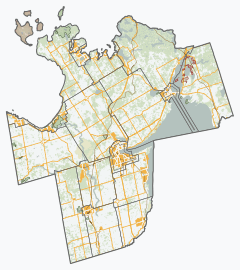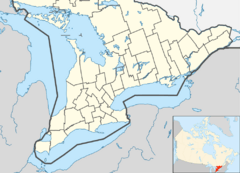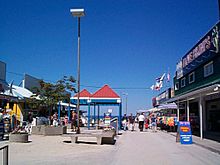Wasaga Beach facts for kids
Quick facts for kids
Wasaga Beach
|
|
|---|---|
|
Town (lower-tier)
|
|
| Town of Wasaga Beach | |
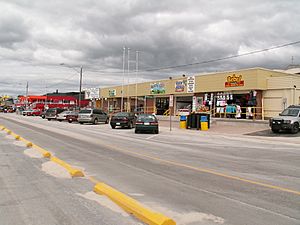 |
|
| Nickname(s):
"The Beach", "Wasaga"
|
|
| Motto(s):
"The Beach is just the Beginning"
|
|
| Country | Canada |
| Province | Ontario |
| County | Simcoe |
| Incorporated | 1951 (as village) January 1, 1974 (as town) |
| Area | |
| • Land | 58.64 km2 (22.64 sq mi) |
| Population
(2021)
|
|
| • Total | 24,862 |
| • Density | 423.9/km2 (1,098/sq mi) |
| Demonym(s) | Wasaga Beacher, Wasagan |
| Time zone | UTC-5 (EST) |
| • Summer (DST) | UTC-4 (EDT) |
| Forward sortation area |
L9Z
|
| Area code(s) | 705 |
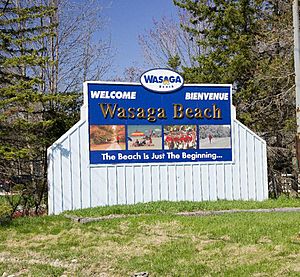
Wasaga Beach (or simply Wasaga or The Beach) is a town in Simcoe County, Ontario, Canada. Situated along the longest freshwater beach in the world, it is a popular summer tourist destination. It is located along the southern end of Georgian Bay, approximately 150 km (93 mi) north of Toronto and about 40 km (25 mi) northwest of Barrie. To the west, Collingwood and The Blue Mountains also attract visitors much of the year. The town is situated along a very long sandy beach on Nottawasaga Bay in Georgian Bay and the winding Nottawasaga River. The beaches are part of the Wasaga Beach Provincial Park; the park area totals 168 hectares (415 acres). Wasaga Beach has a year-round population of 24,862 as of 2021, but during the summer months the population increases with many seasonal residents.
The economy has struggled for some years, particularly since a major fire in late November 2007 destroyed many of the stores. It depends on tourists in an area where the primary shopping season is three to four months per year. In March 2017, the town passed its Downtown Development Master Plan, a 20-year strategy for significant redevelopment of the tourist area and adding a downtown to the business area. The goal is to improve tourism, diversify the economy, and get beyond its "party town" image.
Contents
History
Wasaga Beach and the surrounding area was inhabited by the Huron (Wyandot) people for centuries before they were dispersed in 1650 by the French-allied Algonquin people. The word Nottawasaga is of Algonquin origin. Nottawa means "Iroquois" and saga means "mouth of the river"; the word "Nottawasaga" was used by Algonquin scouts as a warning if they saw Iroquois raiding parties approaching their villages.
In the early 1800s, Upper Canada was drawn into a struggle between Great Britain and the United States. Wasaga Beach evolved into a strategic location in the War of 1812 when the schooner HMS Nancy was sunk at her moorings in an effort by the Americans to cut the supply line to Fort Michilimackinac and points to the north and west. Lumbering was the main industry for the remainder of the 19th century. Logs crowded the river and the bay, floating down to feed local saw mills.
Wasaga Beach's unsuitable sandy soil contributed to the late European settlement of the area, as the lack of suitable farming land made it unattractive to settlers. In the 1820s the first sign of settlement in the area began as John Goessman surveyed Flos Township. In 1826, land was being sold for four shillings an acre. Though unsuitable for farming, the Wasaga Beach area had an abundance of trees. In the late 1830s and throughout the rest of the century the logging industry would play an important role in the development of the area.
During the 1900s, families began to discover the beauty of the area and the beach gradually became a place for family picnics and holidays during the summer months. During the 1940s, while stationed at a nearby military base, servicemen from across Canada visited Wasaga Beach's amusement park, and they made Wasaga Beach known across the country. After the war, Wasaga Beach continued to be a popular place for cottages and day trips, beginning the century-old tradition of city dwellers travelling to the beach in the summer.
Wasaga Beach entered history's headlines in 1934 when the first overseas flight from mainland Canada, across the Atlantic to England and in a plane called the "Trail of the Caribou", used Wasaga Beach's long flat sandy beach as a take off strip.
The town was originally referred to as "the northern border of Flos Sunnidale and Nottawasaga Townships". The first municipal reference occurred when a designation of Local Improvement District emerged in 1947. In 1949, Wasaga Beach progressed to the status of a Police Village in the Township of Sunnidale, and the Police Village graduated to Incorporated Village status in 1951.
The incorporation of the Town of Wasaga Beach became effective January 1, 1974. The permanent population stood at 4,034, a dramatic increase from 1965, when only 500 people called Wasaga Beach home. Today the town has 20,665 full-time residents and 16,000 seasonal and part-time residents.
Wasaga Beach fire
On November 30, 2007, a major fire destroyed 90 per cent of the buildings along the street mall in the Beach One area. About 17 seasonal businesses were said to have been affected, including bikini shops, ice cream parlours, a restaurant, a motel and an arcade. Nearly 100 firefighters from surrounding areas battled the blaze for hours. The Toronto Star later reported that "Twenty-one businesses in eight buildings overlooking Georgian Bay were destroyed, causing an estimated $5 million in damages."
Controversy also arose over whether or not the fire was deliberately set in order to allow unobstructed progression with the planned development or whether it was simply an accident. Two young men (one from Barrie and the other from Springwater) were charged with arson. There was no indication that the fire was deliberately set to remove old buildings in advance of planned development.
The Town of Wasaga Beach worked out a plan to help the remaining businesses open for the season but the hotels, theme park and a monorail were cancelled and never revived.
Economic challenges
Despite the major fire, the beach and the remaining businesses reopened the following summer. Although the destroyed buildings had been considered dated, they were missed by residents and visitors. In 2008, an entertainment dome was built, intended as a temporary structure until development started. It lasted until February 2011 when the exterior cover was destroyed during a storm; repairs were not done and the dome never reopened. The structure was removed in May 2012.
The long-term plans after the fire, by the Levy brothers' Blue Beach Avenue corporation, included a rebuild of the area in a modern style with shopping, an indoor/outdoor theme park, two major hotels and monorail service. The proposed development came to an abrupt end when Blue Beach Avenue declared bankruptcy in 2010. "The past couple of years haven't been kind to the tourist industry ... So I gather there were some major cash shortfalls that put them in this situation," the town's mayor said at that time.
One of the Levy brothers was charged with fraud in 2012 after an investigation of misappropriation of the insurance money paid out after the 2007 fire.
Reduced tourism, partly because of the loss of many retail buildings, has continued to be a problem in the area. The majority of sales take place during the tourist season, which is typically not much longer than three months per year. (The most recent stats indicate a decline in tourism "of roughly 100,000 a year between 2002 and 2012".)
To step up development, in 2015 the town spent $13.5 million to purchase seven properties, including eight buildings and 28 rental units, along Beach Area One, becoming a landlord to some businesses, including three bars. The town acquired any existing leases from tenants and succeeded in leasing most of the empty space to commercial enterprises by July 2016. A few of the tenants subsequently enquired about the possibility of breaking their leases because they were struggling financially. The town council agreed to a one-time opportunity for businesses to break their leases without a penalty; requests to do so had to be submitted no later than September 23, 2016.
The beach is owned and operated by Ontario Parks as the Wasaga Beach Provincial Park, and it is the area's primary attraction. Of the six main beach areas, Beach areas One and Two and the adjacent private/public lands have historically functioned as the main destination for tourism activity. Due to the economic climate, losses due to fires, and recent failed private redevelopment plans, Beach areas One and Two have been in steady decline.
This area is so important to the town that it undertook an in-depth community visioning exercise, called Opportunity Wasaga, to develop a long-term vision for the future of the public and private lands in this area.
There has been a great deal of controversy (among the public and council members) about the previous strategies used by the Town of Wasaga Beach, including the 2015 purchase of the seven properties for $13.8 million, using borrowed money. "That's no small sum for the town of 18,000 that will collect $20.3 million in property taxes this year and spend $48 million in operating and capital costs," according to a report by the Toronto Star.
New development plan
An entirely new Downtown Development Master Plan was released by town council in late January 2017, with an estimate for capital investment of $625 million and a 20 plus year time frame for completion. The first phase (five to 10 years) will cost about $200 million for two development areas, one on the beach and one on the main land. Much of that is expected to be funded by developers.
The plan provides the following specifics, as summarized in a report by the Collingwood, Ontario newspaper Enterprise Bulletin.
The Lower Main area built out would have the following characteristics:
• Size would be 76,500 square metres,
• Include a Town Square
• A community hub
• Traffic roundabouts, streetscape network and on-street parking
• Open space
• Anchor development
• 560 residential units for a population of 900
• 60 retail units which would include 300 to 400 jobs.
The Beach Area built out would have the following characteristics:
• Size would be 124,000 square metres
• Include a Festival Square
• Beach boardwalk
• Hotel with indoor entertainment and boutique
• Restaurant and residential block
• Townhouses
• A performance venue
• An entertainment zone / public space
• A water park
• Residential resort
• 1,200 residential units for a population of 1,700
• 80 retail units
• Jobs for between 800 and 900 people
Mayor Brian Smith recognizes that the plan is ambitious, but offers the following comment. "Unlike previous 'pie in the sky' development schemes, this one is 'realistic, affordable and sustainable'". He believes that it will attract investment and development and reignite the tourism industry.
More recently, and unrelated to the master plan, town council agreed to search for a local painter to beautify the town-owned buildings and to create murals. The budget for this is $31,000. Benjamin Moore has offered to provide the paint at a discount and to arrange for a 90 second spot on the City TV show City Line. The town also plans to install interactive activities at the Main Street Market at a cost of $7,900.
Wasaga Beach Provincial Park
| Wasaga Beach Provincial Park | |
|---|---|
|
IUCN Category II (National Park)
|
|
| Lua error in Module:Location_map at line 420: attempt to index field 'wikibase' (a nil value). | |
| Location | Ontario, Canada |
| Nearest city | Wasaga Beach, Ontario |
| Area | 1,844 ha (7.12 sq mi) |
| Established | 1959 |
| Governing body | Ontario Parks |
Wasaga Beach Provincial Park is a small recreational provincial park consisting of the 8 beaches with 14 kilometers of beach. Beach Areas 1-6 can be accessed off Mosley Street in Wasaga. Allenwood and New Wasaga Beaches are north of the Nottawasaga River and are accessed via River Road East.
The park is available for day use only. Its area totals 1844 hectares of which 6.8 hectares are protected. The park is a shorebird habitat for birds, including the endangered Piping Plover. Hiking trails of over 50 kilometers are available. In winter, they are used for cross-country skiing and snowshoeing. The visitor center provides access to the Nancy Island Historic Site with a theater, a museum and a lighthouse.
Geography
Over two million people visit Wasaga Beach every summer, attracted by the town's freshwater beach (stretching 14 kilometres or 8.7 miles), swim in shallow (warm), clean water and enjoy the panoramic views of the Niagara Escarpment across the bay. There are many recreational trails that are used for hiking, cycling, cross-country skiing and snowmobiling. The Nottawasaga River offers game fishing and canoe routes.
The beach is divided into small sections, with the public beaches numbered 1 to 6 from east to west. (All offer toilet facilities.) A published summary indicates that Beaches 2-4 benefit from shade trees, a bike trail and a playground. Beach 1 is the most touristy, with bars, beach-themed shops and fast food restaurants, attracting primarily young adults. Beach areas 5 and 6 have many seasonal cottages; Shore Lane Rd. is used for jogging, biking and roller blading. There are two additional beaches nearby, New Wasaga and Allenwood that are cut off from the 1-6 areas by the river; these also have seasonal residents and tourists. The town publishes a map of all of these areas.
In the summer months it is a very popular place for beach volleyball and sunbathing. A boardwalk runs most of the way along Beach 1 and 2. Beach 1 draws the largest crowds, with the popularity of the beaches decreasing further west. East of Beach 1, the beach continues as segments named New Wasaga Beach, Allenwood Beach, and on to the Tiny beaches outside of the town limits. The beach in these areas abuts against many homes and cottages close to the water.
The beach's position on the waters of Nottawasaga Bay means that summer temperatures are moderated somewhat by the water, so summer days can be quite comfortable especially when there is a breeze off Georgian Bay. In winter, however, winds off the water trigger very heavy and intense snow squalls. Due to these heavy snowfalls, activities include snowmobiling, Cross-country skiing and other winter sports. Downhill skiing is available at nearby Blue Mountain.
In the winter, there are many miles of fresh groomed trails for snowmobiling thanks to the Ontario Federation of Snowmobile Clubs and in part to the purchasers of the trail passes. The town also has several community centres, including the Rec-Plex, which has an auditorium, an amphitheatre and a YMCA, as well as the Wasaga Stars Arena.
Land area, geology and topography
The Town of Wasaga Beach covers an area of 61.13 square kilometres (23.60 sq mi) comprised predominantly of sand and loamy sand that exhibit excessive to good drainage and irregular to moderately sloping topography. The poor soil quality makes it difficult to sustain lush lawns in the town. The Canada Land Inventory for Agriculture rates the lands as predominately Class Six and Seven with primary restrictions of adverse topography, erosion damage and low natural fertility.
Demographics
| Wasaga Beach Historical populations |
||
|---|---|---|
| Year | Pop. | ±% |
| 1971 | 1,923 | — |
| 1981 | 4,705 | +144.7% |
| 1991 | 6,224 | +32.3% |
| 1996 | 8,698 | +39.7% |
| 2001 | 12,419 | +42.8% |
| 2006 | 15,029 | +21.0% |
| 2011 | 17,537 | +16.7% |
| 2016 | 20,675 | +17.9% |
| 2021 | 24,862 | +20.3% |
In the 2021 Census of Population conducted by Statistics Canada, Wasaga Beach had a population of 24,862 living in 10,811 of its 13,768 total private dwellings, a change of 20.3% from its 2016 population of 20,675. With a land area of 57.42 km2 (22.17 sq mi), it had a population density of 433.0/km2 (1,121/sq mi) in 2021.
| Canada census – Wasaga Beach community profile | |||
|---|---|---|---|
| 2016 | 2011 | 2006 | |
| Population: | 20,675 (17.9% from 2011) | 17,537 (16.7% from 2006) | 15,234 (21.0% from 2001) |
| Land area: | |||
| Population density: | 352.6/km2 (913/sq mi) | 300.1/km2 (777/sq mi) | 257.2/km2 (666/sq mi) |
| Median age: | 55.3 (M: 54.3, F: 56.2) | 48.8 (M: 47.8, F: 49.9) | |
| Total private dwellings: | 12,516 | 11,645 | 9,938 |
| Median household income: | $62,150 | $54,181 | |
| Notes: Includes corrections and updates. – References: 2016 2011 2006 earlier | |||
The 2006 Canadian census indicated a population of 15,029 residents. When compared to its 2001 population of 12,419, Wasaga Beach was one of the fastest-growing communities in Canada, based on population growth percentage (21.0% over 5 years).
Wasaga Beach Transit
Transit service in Wasaga Beach is operated by Georgian Coach Lines, using town-owned buses, under the name Wasaga Beach Transit. The service was started with one route in July 2008, and quickly expanded to two routes in the summer of 2009. Services for Wasaga Beach Transit occur in a loop from the Wasaga Stars Arena in the east to the Real Canadian Superstore in the west every hour from 7 am to 7 pm. There is a transit link between Wasaga Beach and Collingwood that operates on a continuous loop.
Education
There are several elementary schools: Worsley, Birchview Dunes, and St. Noel Chabanel (Catholic); and a private school, Silvercrest Christian School. There are no high schools in town. As of February 2017, there was no plan by the Simcoe County District School Board or the Simcoe-Muskoka Catholic District School Board to build a secondary school. Buses transport over 760 students to high schools located outside the town, in Stayner, Elmvale, and Collingwood.
Schools in Wasaga Beach:
- Birchview Dunes Elementary School
- Principal: Melissa Mortimer
- Worsley Elementary School
- Principal: Darrell Bax
- St Noel Chabanal Elementary School
- Principal: Tammy Mayer
Notable residents
- Jason Arnott – NHL hockey player; born in Collingwood and raised in Wasaga Beach; in the summer of 2000, Jason Arnott Day was declared in Wasaga Beach to celebrate his Stanley-Cup-winning goal scored in double overtime
- Adam Copeland and Jason Reso – WWE stars better known as Edge and Christian; lived together in Wasaga Beach throughout their time in college and early training
Images for kids


